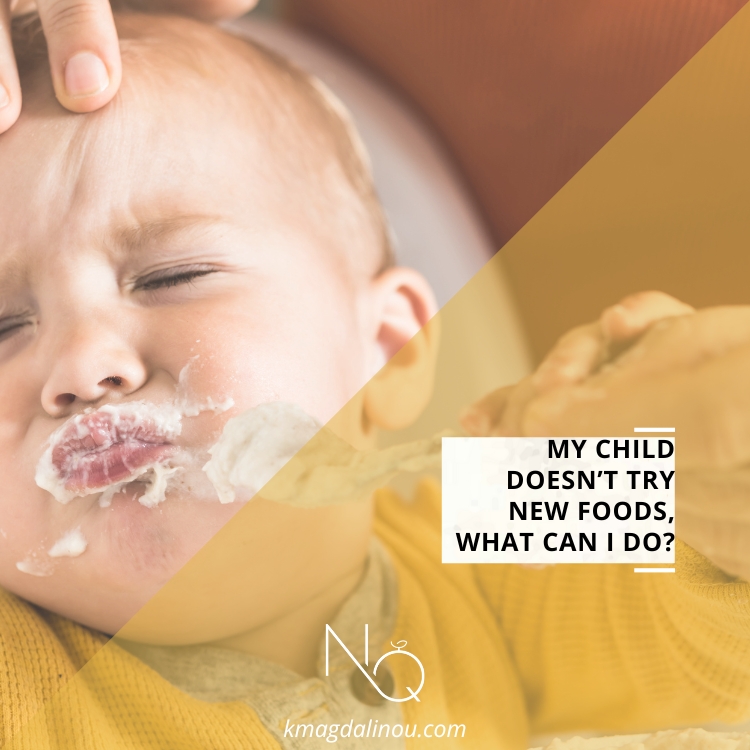Food neophobia is a common phenomenon, especially during the early years of life, though it is not necessarily absent in adulthood. In this article, we will talk about food neophobia in children and how we can intervene and manage it.
What is food neophobia?
Food neophobia is the phenomenon where an individual refuses to consume or try new foods, resulting in a monotony of food choices. Due to the limited variety of foods consumed, deficiencies in nutrients often occur.
This behavior appears most frequently between the ages of 2–5, which is also the most important period for shaping a child’s eating habits. The risk of food neophobia decreases during adolescence and adulthood, while in older age the risk increases again.
Food neophobia is more commonly observed during childhood because it is the stage where a child begins exploring and discovering new tactile, taste, and smell experiences. As a result, their dietary habits are shaped during this period.
Consequences of food neophobia in children
Due to food neophobia, the number of foods children accept to consume is reduced, which leads to limited intake of essential nutrients. Sufficient nutrient intake is necessary for maintaining various body functions. Therefore, when food neophobia persists for a long time or when food restriction is severe, there is a risk of compromising different body systems. One of the systems affected is the nervous system, which can negatively influence a child’s cognitive and motor skills.
Factors that promote childhood food neophobia:
The factors that increase the risk of food neophobia can be biological, psychological, individual, economic, anthropological, and sociocultural. Below are some specific factors that contribute to the development of this phenomenon during childhood:
- Parents’/guardians’ eating habits
• Pressure from parents/guardians to eat
• Lack of encouragement and/or affection from parents/guardians
• Difficulty interpreting hunger and satiety cues by parents/guardians
• Diets with little variety and low nutritional quality
• Lack of exposure to new foods
• Negative reactions to new stimuli
• Mothers with neophobia
• Lack of autonomy in the child’s eating habits
• Children’s preference for sweet and salty tastes
• Sensory characteristics of foods
• Child’s anxiety
Assessment of food neophobia in children
The tool used in various countries is the CNFS (Children’s Food Neophobia Scale), with different adaptations. This tool evaluates the degree of food neophobia in children. It consists of 8 questions, with answers given on a Likert scale from 1 to 5, where 1 corresponds to “Strongly disagree” and 5 to “Strongly agree.” The lowest possible score is 8, and the highest is 40. The higher the score, the greater the degree of food neophobia in the child. This tool is completed by parents/guardians.
Possible practical ways to manage childhood food neophobia
To intervene in order to manage our child’s food neophobia, we can follow various practices either at home or in the school environment. Some of these are:
- Food and nutrition education with an emphasis on eating habits during childhood
• Variety in the diet, including foods outside of the family’s usual habits
• Encouraging children’s autonomy in their eating habits
• Emotional support for children
• Involvement in meal preparation in a pleasant environment
Food neophobia in children is a common phenomenon that we can address to avoid future negative consequences. In collaboration with a Dietitian-Nutritionist, we can learn to recognize the signs and seek help, so we can support our child with appropriate practices.
REFERENCES
- Torres TO, Gomes DR, Mattos MP. Factors associated with food neophobia in children: systematic review. Rev Paul Pediatr. 2020;39:e2020089. doi:10.1590/1984-0462/2021/39/2020089.
- Wiernicka A, Piwczynska K, Mika-Stepkowska P, Kazimierska D, Socha P, Rybak A. Impact of the gut-brain hormonal axis and enteric peptides in the development of food neophobia in children with genetically determined hypersensitivity to the bitter taste. Gastrointest Disord. 2022;4(4):237-248. doi:10.3390/gidisord4040023.




